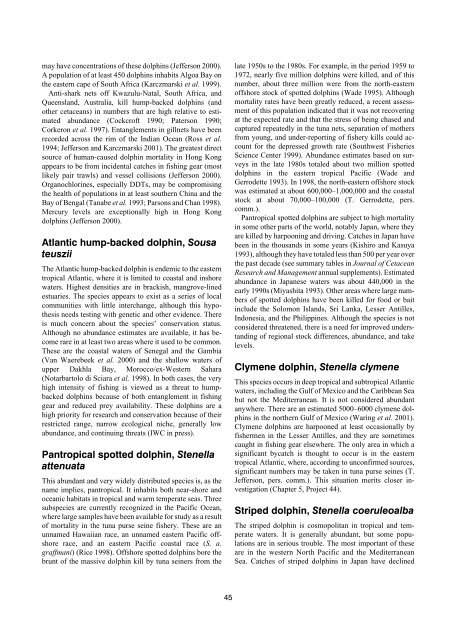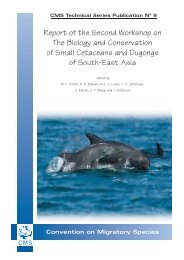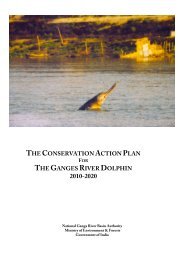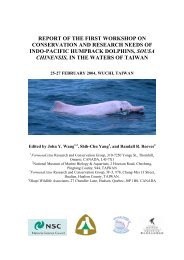Dolphins, Whales and Porpoises: 2002-2010 Conservation - IUCN
Dolphins, Whales and Porpoises: 2002-2010 Conservation - IUCN
Dolphins, Whales and Porpoises: 2002-2010 Conservation - IUCN
You also want an ePaper? Increase the reach of your titles
YUMPU automatically turns print PDFs into web optimized ePapers that Google loves.
may have concentrations of these dolphins (Jefferson 2000).<br />
A population of at least 450 dolphins inhabits Algoa Bay on<br />
the eastern cape of South Africa (Karczmarski et al. 1999).<br />
Anti-shark nets off Kwazulu-Natal, South Africa, <strong>and</strong><br />
Queensl<strong>and</strong>, Australia, kill hump-backed dolphins (<strong>and</strong><br />
other cetaceans) in numbers that are high relative to estimated<br />
abundance (Cockcroft 1990; Paterson 1990;<br />
Corkeron et al. 1997). Entanglements in gillnets have been<br />
recorded across the rim of the Indian Ocean (Ross et al.<br />
1994; Jefferson <strong>and</strong> Karczmarski 2001). The greatest direct<br />
source of human-caused dolphin mortality in Hong Kong<br />
appears to be from incidental catches in fishing gear (most<br />
likely pair trawls) <strong>and</strong> vessel collisions (Jefferson 2000).<br />
Organochlorines, especially DDTs, may be compromising<br />
the health of populations in at least southern China <strong>and</strong> the<br />
Bay of Bengal (Tanabe et al. 1993; Parsons <strong>and</strong> Chan 1998).<br />
Mercury levels are exceptionally high in Hong Kong<br />
dolphins (Jefferson 2000).<br />
Atlantic hump-backed dolphin, Sousa<br />
teuszii<br />
The Atlantic hump-backed dolphin is endemic to the eastern<br />
tropical Atlantic, where it is limited to coastal <strong>and</strong> inshore<br />
waters. Highest densities are in brackish, mangrove-lined<br />
estuaries. The species appears to exist as a series of local<br />
communities with little interchange, although this hypothesis<br />
needs testing with genetic <strong>and</strong> other evidence. There<br />
is much concern about the species’ conservation status.<br />
Although no abundance estimates are available, it has become<br />
rare in at least two areas where it used to be common.<br />
These are the coastal waters of Senegal <strong>and</strong> the Gambia<br />
(Van Waerebeek et al. 2000) <strong>and</strong> the shallow waters of<br />
upper Dakhla Bay, Morocco/ex-Western Sahara<br />
(Notarbartolo di Sciara et al. 1998). In both cases, the very<br />
high intensity of fishing is viewed as a threat to humpbacked<br />
dolphins because of both entanglement in fishing<br />
gear <strong>and</strong> reduced prey availability. These dolphins are a<br />
high priority for research <strong>and</strong> conservation because of their<br />
restricted range, narrow ecological niche, generally low<br />
abundance, <strong>and</strong> continuing threats (IWC in press).<br />
Pantropical spotted dolphin, Stenella<br />
attenuata<br />
This abundant <strong>and</strong> very widely distributed species is, as the<br />
name implies, pantropical. It inhabits both near-shore <strong>and</strong><br />
oceanic habitats in tropical <strong>and</strong> warm temperate seas. Three<br />
subspecies are currently recognized in the Pacific Ocean,<br />
where large samples have been available for study as a result<br />
of mortality in the tuna purse seine fishery. These are an<br />
unnamed Hawaiian race, an unnamed eastern Pacific offshore<br />
race, <strong>and</strong> an eastern Pacific coastal race (S. a.<br />
graffmani) (Rice 1998). Offshore spotted dolphins bore the<br />
brunt of the massive dolphin kill by tuna seiners from the<br />
late 1950s to the 1980s. For example, in the period 1959 to<br />
1972, nearly five million dolphins were killed, <strong>and</strong> of this<br />
number, about three million were from the north-eastern<br />
offshore stock of spotted dolphins (Wade 1995). Although<br />
mortality rates have been greatly reduced, a recent assessment<br />
of this population indicated that it was not recovering<br />
at the expected rate <strong>and</strong> that the stress of being chased <strong>and</strong><br />
captured repeatedly in the tuna nets, separation of mothers<br />
from young, <strong>and</strong> under-reporting of fishery kills could account<br />
for the depressed growth rate (Southwest Fisheries<br />
Science Center 1999). Abundance estimates based on surveys<br />
in the late 1980s totaled about two million spotted<br />
dolphins in the eastern tropical Pacific (Wade <strong>and</strong><br />
Gerrodette 1993). In 1998, the north-eastern offshore stock<br />
was estimated at about 600,000–1,000,000 <strong>and</strong> the coastal<br />
stock at about 70,000–100,000 (T. Gerrodette, pers.<br />
comm.).<br />
Pantropical spotted dolphins are subject to high mortality<br />
in some other parts of the world, notably Japan, where they<br />
are killed by harpooning <strong>and</strong> driving. Catches in Japan have<br />
been in the thous<strong>and</strong>s in some years (Kishiro <strong>and</strong> Kasuya<br />
1993), although they have totaled less than 500 per year over<br />
the past decade (see summary tables in Journal of Cetacean<br />
Research <strong>and</strong> Management annual supplements). Estimated<br />
abundance in Japanese waters was about 440,000 in the<br />
early 1990s (Miyashita 1993). Other areas where large numbers<br />
of spotted dolphins have been killed for food or bait<br />
include the Solomon Isl<strong>and</strong>s, Sri Lanka, Lesser Antilles,<br />
Indonesia, <strong>and</strong> the Philippines. Although the species is not<br />
considered threatened, there is a need for improved underst<strong>and</strong>ing<br />
of regional stock differences, abundance, <strong>and</strong> take<br />
levels.<br />
Clymene dolphin, Stenella clymene<br />
This species occurs in deep tropical <strong>and</strong> subtropical Atlantic<br />
waters, including the Gulf of Mexico <strong>and</strong> the Caribbean Sea<br />
but not the Mediterranean. It is not considered abundant<br />
anywhere. There are an estimated 5000–6000 clymene dolphins<br />
in the northern Gulf of Mexico (Waring et al. 2001).<br />
Clymene dolphins are harpooned at least occasionally by<br />
fishermen in the Lesser Antilles, <strong>and</strong> they are sometimes<br />
caught in fishing gear elsewhere. The only area in which a<br />
significant bycatch is thought to occur is in the eastern<br />
tropical Atlantic, where, according to unconfirmed sources,<br />
significant numbers may be taken in tuna purse seines (T.<br />
Jefferson, pers. comm.). This situation merits closer investigation<br />
(Chapter 5, Project 44).<br />
Striped dolphin, Stenella coeruleoalba<br />
The striped dolphin is cosmopolitan in tropical <strong>and</strong> temperate<br />
waters. It is generally abundant, but some populations<br />
are in serious trouble. The most important of these<br />
are in the western North Pacific <strong>and</strong> the Mediterranean<br />
Sea. Catches of striped dolphins in Japan have declined<br />
45





